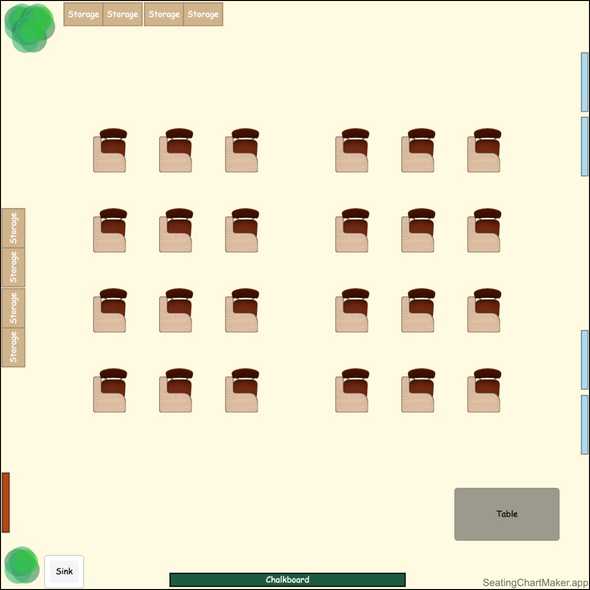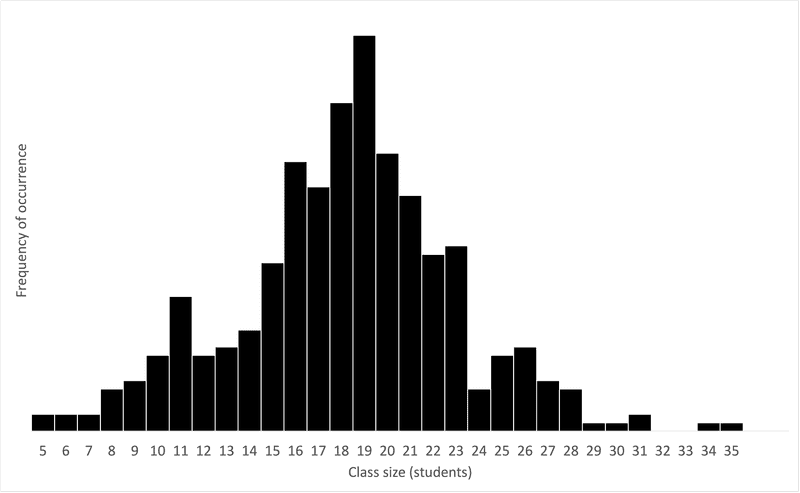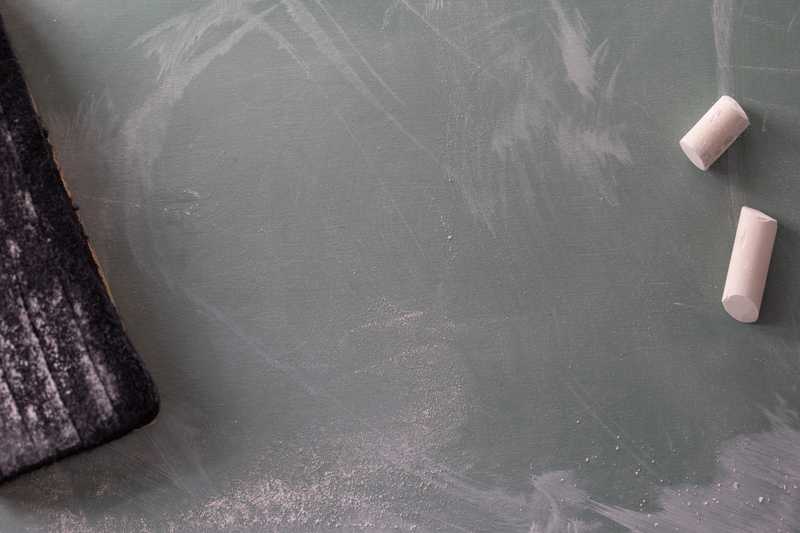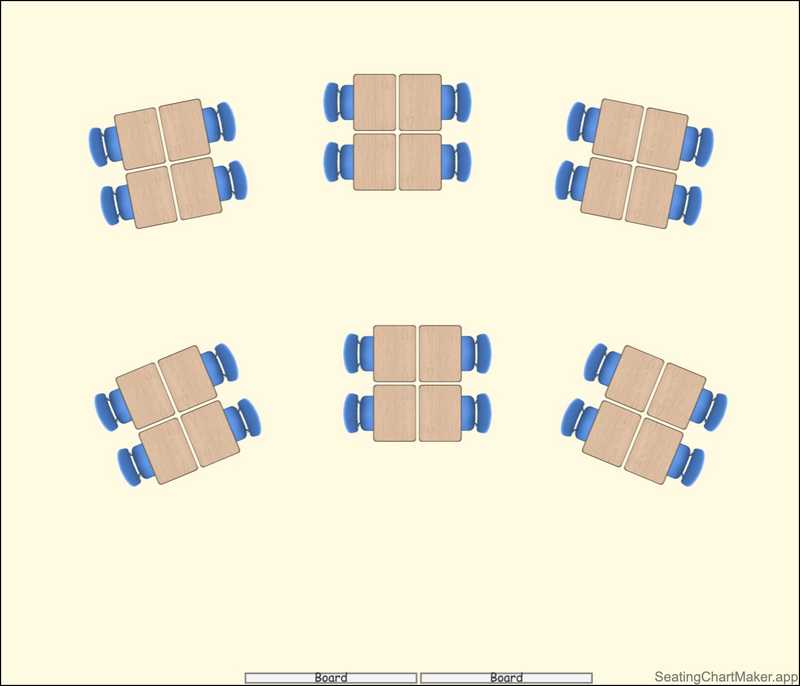Average Classroom Size (Square Feet/Meters) [2024]

The average size (surface area) of a classroom in the United States is approximately 900 square feet (84 m²). You’ll find most classrooms varying between 700 and 1,100 square feet (65 and 102 m²). These dimensions apply to primary, middle, and high schools for normal educational activities.
Classrooms are commonly square or slightly rectangular, typically with the teaching board on the shorter side. A common layout measures around 30 feet by 30 feet (9 meters by 9 meters). Ceiling height is typically about 9 feet (274 centimeters).
 Figure 1: A layout of a 30ft x 30ft (900 square feet) classroom accommodating 24 desks in a grid formation. Create a custom-size layout.
Figure 1: A layout of a 30ft x 30ft (900 square feet) classroom accommodating 24 desks in a grid formation. Create a custom-size layout.
When class size is measured in students, the average and median number in the US hovers around 20 students, though figures can range from 15 to 26 students per classroom (see histogram visualization). This translates to roughly 45 square feet (4.2 square meters) per student, ensuring more than adequate space for each individual to learn and interact comfortably, well above minimum spatial requirements.
Various factors, such as the type of classroom, academic year, and geographical differences across states and countries, contribute to variations in classroom sizes. Additionally, the data on this topic can be sparse and sometimes inconsistent. Therefore, the floor area estimates we discuss here are based on a combination of direct data, reasoning, and educated guesses.
My motivation for researching classroom sizes came from the need to provide the best possible templates and defaults for the Seating Chart Maker users. I couldn’t find any source that provides a comprehensive overview of classroom sizes, so I decided to compile information from sources such as state guidelines and architectural documents to give you a more complete picture.
In the following sections, I provide further details from various sources and discuss them. So, without further ado, let’s dive into the details.
Contents
- A Closer Look at Average Classroom Size in Square Feet in the US
- Classroom size by US state
- Classroom Size by Activity Type, Age, and Student Count
- Classroom Size Recommendations Derived from Research
- Standard Classroom Size for Different Class Sizes
- Comparing Classroom Sizes in Square Feet Across Countries
- Standard Dimensions of School Desks
- Conclusion
- References
A Closer Look at Average Classroom Size in Square Feet in the US
Classroom dimensions play a key role in the learning environment. In the following sections, we’ll review available data, such as state guidelines, estimations, and expert views on classroom sizes across the United States.
Direct Data: Classroom Size Specifications
According to an article from Architectural Record, classrooms in many schools typically range from 800 to 1,100 square feet (74 to 102 m²), planned to accommodate about 20 to 30 students. Mentioned common sizes are:
- 28 by 30 feet: 840 sq ft (8.5 by 9 m: 76.5 m²)
- 30 by 30 feet: 900 sq ft (9 by 9 m: 81 m²)
- 32 by 32 feet: 1024 sq ft (10 by 10 m: 100 m²).
These dimensions result in square or slightly rectangular-shaped classrooms. The article is centered around the design of new wood-framed school buildings. Still, we can assume the presented figures describe the typical classroom sizes in the US, as they are presented as a background for school building design. There is no reason to believe classroom sizes should differ from the normal in wood-framed schools. However, the source of these numbers remains unspecified in the article, so we should take them with a grain of salt.
Tanner refers to the recommended classroom sizes in the US, noting that the typical elementary school classroom is approximately 900 square feet (84 m²). In contrast, for secondary schools, it is 1024 square feet (95 m²). However, as with the previous source, Tanner does not provide specific sources for his figures. Despite this, we can consider these as indicative of the current recommendations in effect, although further investigation is needed for absolute certainty.
A Calculated Approach: Estimations Based on Indirect Data
We can estimate a typical classroom size from the average number of students and general recommendations or standards for per-student square footage in classrooms.
For instance, although a national standard for classroom square footage per student does not exist, some states have defined guidelines with classroom sizes ranging from 25 square feet (2.3 m²) to 45 square feet (4.2 m²) per student.
According to the Illinois Administrative Code’s Space Utilization Report, classroom capacity is calculated by dividing the net classroom area by 35 square feet (3.3 m²).
The National Center for Education Statistics (NCES) data shows an average class size of 20 students, with most classes having 15 to 26 students. Consequently, an estimated average classroom size could fall between 525 square feet (35 sq ft/student times 15 students) and 910 square feet (35 sq ft/student times 26 students) (49 and 85 m²). However, this calculation has potential issues as classrooms should probably be designed with some tolerance to accommodate more students than the current average. Moreover, the average student count per class in the US has seen a slight decrease over time (NCES). Therefore, the average classroom size will likely exceed the estimated range.
Required Classroom Sizes: State Minimum Standards
In California, under the California Code of Regulations, Title 5, School Facilities Construction, classrooms constructed for grades one through twelve should have at least 960 square feet (89 m²) of floor space. Justifications are required for classrooms smaller than this, explaining the classroom’s suitability for the district’s educational program.
Meanwhile, the New York State Education Department (NYSED) requires a minimum of 770 square feet (72 m²) for both elementary and secondary school classrooms (for up to 15 students), maintaining a standard of 50 square feet (4.6 m²) per student. Here, classroom designs favor a rectangular layout rather than a perfect square.
The Texas Education Agency (TEA) sets a minimum requirement of 700 square feet (65 m²) and a per-student space of 28-30 square feet (2.6-2.8 m²).
On the other hand, Georgia’s Department of Education (GaDOE) has defined a minimum classroom size of 600-750 square feet (56-70 m²).
State minimums for classroom sizes, varying from 600 to 960 square feet (56 to 89 m²), suggest that the average classroom size in the US likely exceeds these figures. These minimums provide a baseline, with actual sizes possibly influenced by current and possible future class sizes, other tolerances, estimated benefits of extra space, availability of spaces, and teaching methodologies.
Based on the above data, the estimated average classroom size is approximately 900 square feet (84 m²), typically between 700 and 1,100 square feet (65 and 102 m²). There’s no evidence suggesting that the distribution of classroom sizes is skewed. Hence, it’s reasonable to deduce that the median classroom size also approximates 900 square feet.
Classroom Size by US State
In the United States, a national standard specifying the required square footage per student for general classrooms has yet to be created. However, specific states, including Illinois, have implemented such requirements, with the average classroom size ranging from 25 to 45 square feet (2.3 to 4.2 m²) per student (Space Utilization Report).
Below is a table indicating the required classroom size in square feet per student and the total required classroom size in square feet in select states.
Classroom Size by State
| State | Average class size (students) | Required classroom min. size (sq ft/student) | Required classroom min. size (sq ft) |
|---|---|---|---|
| NYC | 19 | 17-22, 50 (1.6-2.0, 4.6 m²) | |
| California | 24 | 960 (89 m²) | |
| Texas | 20 | 28-30 (2.6-2.8 m²) | 700 (65 m²) |
| Pennsylvania | 21 | 25-30 (2.3-2.8 m²) | |
| Illinois | 20 | 25-45 (2.3-4.2 m²) | |
| Georgia | 20 | 600-750 (56-70 m²) |
The data presented in the table is applicable to primary and secondary education classrooms and does not include special classrooms such as those for science, art, or music.
The table displays a variety of classroom size standards across six states in the US. Notably, some states, such as New York City and Pennsylvania, provide specifications regarding square footage per student, while others, like California and Georgia, set requirements for total classroom size. Texas offers both types of measures.
Classroom Size by Activity Type, Age, and Student Count
Classroom sizes can vary significantly based on the type of activity, the age of the students, and the number of students in a class. This section of the article explains how these factors influence the average square-foot classroom size.
Age Factor in Classroom Size
Generally, the recommendations are that classrooms for younger students are larger in comparison to those used by older students. For instance, here are some average sizes according to grade level:
- Grades K-3: 750 square feet (70 m²)
- Grades 4-8: 660 square feet (61 m²)
- Grades 9-12: 600 square feet (56 m²) (GaDOE)
This difference in space allocation could be attributed to the diverse learning needs of younger children, which require more physical space for learning activities.
In addition, younger students likely require, on average, more teaching staff per student, which could necessitate larger classrooms. Teachers also need their space in the classroom.
Classroom Size Based on Activity Type
In addition to age, the nature of the activities taking place within a classroom also plays a crucial role in determining its size. Classrooms designated for specific subjects such as music, science, or art usually require more space than standard academic classrooms (GaDOE). For those looking to design or redesign their classroom layouts, a seating chart maker software can help visualize different setups efficiently, whether for general instruction or specialized subjects like art and science.
It is important to note that, unless stated otherwise, the measurements provided in this article primarily refer to regular classrooms, not specialized ones.
Classroom Size Recommendations Derived from Research
According to research conducted by Tanner, it is proposed that the ideal classroom size for an elementary school accommodating 20 students and one teacher is 1,029 square feet (96 m²). In contrast, secondary school classrooms should be 1,344 square feet (125 m²). More than just the raw square footage, the density of a classroom plays a significant role.
In addition, it was noted that the classroom should provide at least 72 square feet (6.70 m²) of window area for natural light. Additionally, the classrooms should offer views that foster engagement and learning, and there should be direct access to the outdoors (Tanner and Heschong Mahone Group).
Criticism of Tanner’s Study
However, Tanner himself recognizes that the methodologies and outcomes of his study can be criticized. One key point of criticism is Tanner’s reliance on ‘social distance’ as a metric for determining optimal classroom size.
Another issue is the assumption of a causal link (instead of just a correlation) between classroom size (in square feet) or density and learning outcomes. Larger or less dense classrooms could result from more extensive resources that also contribute to improved learning results regardless of the classroom size, leading to a correlation versus causality debate.
Even with the criticisms, Tanner's study is relevant to how we think about classroom sizes. It suggests classrooms need to be bigger than currently, or we need fewer students in each class. If we believe Tanner's recommendation, it's good news that, with the trend of decreasing number of students in each class, the amount of space per student (classroom density) likely increases if the average classroom size in square feet stays the same.
Standard Classroom Size for Different Class Sizes
The average class size in the US is 20 students, with most classes having 15 to 26 students. An average classroom size of 900 square feet (84 m²) results in an estimated average of 45 square feet (4.2 m²) per student. Most state guidelines allow for less area per student. For example, Illinois calculates classroom student capacity as 35 sq ft per student number.
Let’s calculate some estimated classroom sizes for different class sizes.
Please note that while the calculated square footage is precise, the length and width of the room in feet are approximated examples, assuming a nearly square room.
Estimated Classroom Sizes for Different Class Sizes
| Class size (students) | Classroom size (roomy, 45 sq ft/student) | Classroom size (compact, 35 sq ft/student) |
|---|---|---|
| 15 | 675 sq ft (26 by 26 ft) | 525 sq ft (23 by 23 ft) |
| 18 | 810 sq ft (28 by 29 ft) | 630 sq ft (25 by 25 ft) |
| 20 | 900 sq ft (30 by 30 ft) | 700 sq ft (26 by 27 ft) |
| 22 | 990 sq ft (31 by 32 ft) | 770 sq ft (28 by 28 ft) |
| 25 | 1125 sq ft (34 by 33 ft) | 875 sq ft (30 by 29 ft) |
| 30 | 1350 sq ft (37 by 37 ft) | 1050 sq ft (32 by 33 ft) |
| 40 | 1800 sq ft (42 by 43 ft) | 1400 sq ft (37 by 38 ft) |
| 50 | 2250 sq ft (47 by 48 ft) | 1750 sq ft (42 by 42 ft) |
The table shows an estimated standard classroom size for 20 students would be from 700 to 900 square feet (65 to 84 m²). The typical classroom size for 25 students would be 875 to 1125 square feet (81 to 105 m²). The standard classroom sizes for 30 students would be 1050 to 1350 square feet (98 to 125 m²). And so on.
As the class size increases, the standard classroom size likely increases slower. This is because the classroom size is determined by the number of students and the required space for the teacher and other furniture, which is a constant. Another reason is that larger classes are more likely to be held in more lecture-style classrooms, where students are seated in rows, which can accommodate more students in a smaller area.
Comparing Classroom Sizes in Square Feet Across Countries
This section presents an international perspective on the average classroom area, with data from several countries.
According to a 2009 OECD study, Asian nations like Korea and Japan, who are known to perform well when it comes to education, demonstrate larger class sizes in comparison to the US—with 31 students in Korea and 28 in Japan. However, more recent class size trends show that at least Korean class sizes have decreased in recent years. This may suggest that the average classroom area tends to be larger in these Asian countries.
In contrast, some European nations and Russia have slightly smaller class sizes than the US average, indicating smaller classroom areas.
Reports from China show that the country can have colossal class sizes that exceed 100 students. Despite the very large number of students, these classrooms maintain a compact environment of roughly 20 square feet (1.9 m²) per student. Consequently, the classroom size reaches approximately 2,000 square feet (186 m²) — double the size of the average US classroom.
Standard Dimensions of School Desks
For reference, here are some typical school furniture sizes. The standard measurements for school desks can vary. Here’s a brief overview of typical dimensions:
| Desk Type | Size (inches) | Size (mm) |
|---|---|---|
| Regular school desk | 24” x 18” | 600mm x 450mm |
| Integrated desk with armrest | 20” x 12” + armrest | 500mm x 300mm + armrest |
| School lab desk | 48” x 24” | 1200mm x 600mm |
Conclusion
The average size of a classroom in the United States is approximately 900 square feet (84 m²)-often between 700 and 1,100 square feet (65 and 102 m²).
Classrooms typically accommodate an average of 20 students, or around 45 square feet per student (4.2m²).
Classroom sizes vary significantly with country, classroom type, school year, and more. The size requirements also differ by state; for example, California requires a minimum of 960 square feet per classroom, while Texas sets a minimum of 700 square feet.
For those interested in exploring different classroom configurations, such as grids, rows, or clusters, to maximize space and enhance learning, consider reading our resource on different classroom layout templates.
References
- Architectural Record -magazine, “Designing Modern Wood Schools”, January 2017.
- California Code of Regulations, Title 5, “School Facilities Construction”. Last reviewed on May 12, 2023.
- Georgia Department of Education, Facilities Services Unit, “Guideline for Square Footage Requirements for Educational Facilities”, May 2012.
- “Hadley Junior High School - Space Utilization Study Updates”, April 28, 2015.
- Mayer, Daniel P., Mullens, John E., and Moore, Mary T., “Monitoring School Quality: An Indicators Report”, National Center for Education Statistic, December 2000.
- National Teacher and Principal survey, The National Center for Education Statistic, “Average class size in public schools, by class type and state: 2017–18”.
- New York State Department of Health, Bureau of Emergency Medical Services, “Classroom Design Standards”, April 2010.
- Organisation for Economic Co-operation and Development, “Education at a Glance 2009: OECD Indicators”.
- Pennsylvania Code, § 59.33. Indoor/outdoor space.
- Sixth Tone, Wang Yiwei, “How China Manages Its Supersized Classrooms”, August 02, 2017.
- Tanner C. K., “Minimum Classroom Size and Number of Students Per Classroom”, September 1, 2009.
- Texas Education Agency, “Commissioner’s Rules Concerning School Facilities”, June 2003.
- The State Education Department, The University of the State of New York, “State Building Aid for Public School Districts and BOCES”.





